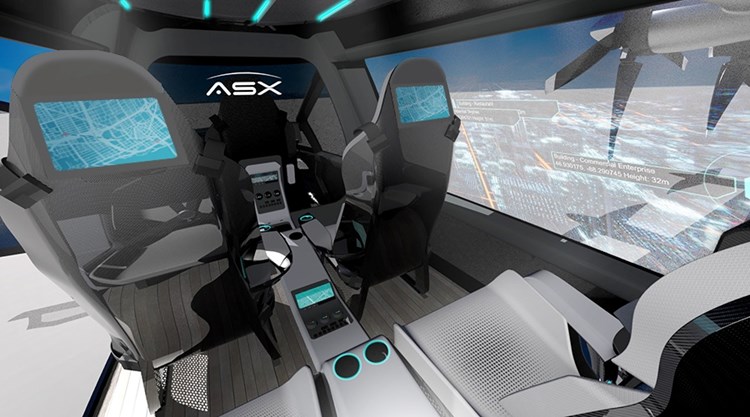Ahead of the Global Urban Air Summit, FINN talks to Dr Anita Sengupta, Chief Product Officer and Vice President of Business Development, Airspace Experience Technologies.
At the inaugural Global Urban Air Summit (GUAS) next month (September 3-4, Farnborough), Dr Anita Sengupta, Chief Product Officer and Vice President of Business Development, Airspace Experience Technologies (ASX), will deliver a keynote presentation entitled From Flying cars to humans on Mars – the future of transportation.
Here, she talks to FINN about how these related areas of innovation interact and what’s required to get urban air mobility off the ground.
Airspace Experience Technologies
Out of its headquarters at Detroit City Airport, Airspace Experience Technologies (ASX) is developing the Mobi-One, an electric vertical take-off and landing (eVTOL) tilt-wing aircraft.
The company’s goal is to produce and operate fleets of safe and reliable aircraft that will vastly reduce commute times, while producing zero operational emissions.
Equipped with zero-emission electric propulsion and broadband ‘V2X’ vehicle-to-vehicle connectivity, a fully electric Mobi-One will deliver an estimated range of 100 miles and a cruising speed of 150 mph, giving it the ability to reduce a 60 minute commute to 15 minutes or less for the price of a ground vehicle for hire (one pilot, four passengers), ASX says. With a hybrid propulsion system, Mobi-One is capable of up to 300 miles of range for regional travel and cargo using general aviation airports.
Sarah Wray (SW): What timescales are you looking at for the Mobi-One aircraft?
Anita Sengupta (AS): ASX is planning to deliver 2,500 aircraft by 2025, with cargo deliveries starting in 2022 and passenger service by 2025.
SW: What challenges and major milestones do you need to get past to reach these goals?
AS: We have to go through a full certification programme, especially for a cargo-carrying flight, so that has all the traditional engineering challenges associated with it.
Also, since it’s a fully electric aircraft, some of the use cases will require updates on the Federal Aviation Administration (FAA) regulatory front.
SW: Those are ambitious goals. Some people are sceptical about whether we will see urban air mobility operations so fast. What would you say?
AS: It really depends upon the use case. A lot of the challenges, at least in the United States, relate to FAR (Federal Aviation Regulations) Part 135. From a business perspective, focusing on cargo makes a lot of sense for us because we’ll be able to start that even with initial experimental certification.
We plan to roll out the use of our vehicles using existing general aviation airports in the United States, which doesn’t require new infrastructure.

SW: What major advantages do you think urban air mobility initiatives such as yours will bring?
AS: The challenge with fully electric aviation is it’s limited in range because of the energy density of batteries. The urban air mobility use case is inherently a short-range application so it allows the use of fully electric aircraft to complete the mission.
That’s the unique coupling of a brand new use case, which solves the congestion problem and reduces the carbon footprint, which is also built to be short-range, meaning the system can be fully electric.
SW: You say your goal is to make personal air mobility more affordable for everyone – what is the role of partnerships in making this a reality?
AS: I think people are very excited about urban air mobility but they’re worried about the affordability of it. For instance, to ride a helicopter, you have to be wealthy so that’s not really a mode of mass transit. The only way this becomes something that the general public can take part in is if you lower the cost.
It’s the job of all the companies out there to create vehicles which meet performance and safety requirements but are a lot less expensive than a traditional helicopter so that regular people can afford to fly them.
We’re based in Detroit, Michigan, which is the automotive capital of the United States and perhaps the world.
We’re looking for synergies with the automotive sector for the development of these aircraft from a power train perspective, meaning electric motors, batteries and power distribution systems, as well as from a mass volume production manufacturing perspective.
Unlike traditional general aviation, or even high-altitude commercial aviation, where the volumes are quite low, we’re looking at many thousands of units per year for urban air mobility to take off. That’s where the automotive volume production and engineering manufacturing approaches come into play.
We are also looking at partnerships with logistics companies. We partnered with a local Midwestern logistics company, for example, to start studying how we can implement our vehicles into their [operations].
SW: Does this mean the aerospace industry could lose business to automotive companies?
AS: I don’t think so. If this market does take off, the volumes just go way up so if anything, larger revenues would be generated.
It does require a paradigm shift in thinking about the way of doing things, though – going from small unit manufacturing to mass-production manufacturing. That’s something that the industry will have to think about.
We’re the people who are going to make this happen and the urban air mobility community can be the driving force behind sustainable aviation. We should collaborate to make it happen.
SW: You come from a background of working at both NASA and Virgin Hyperloop. How does this impact the work you’re doing on urban air mobility?
AS: After engineering complex vehicles that land on other planets – from an engineering perspective, urban air mobility is not so complex. However, from a public acceptance and regulatory perspective, it is certainly new and different.
Inherent to the space programme, though, is the ability to engineer systems which have never existed before, so it actually couples nicely to developing new technologies for terrestrial applications.
Hyperloop is more like a spacecraft travelling on the ground, but for mass transportation. It is very energy-efficient. And, because of the energy-efficiency and the use of a fully electric power train, there are also synergies there in terms of the hardware.
Of course, with hyperloop, we didn’t even have a regulatory body, let alone a separate regulation. In the United States, we already have the FAA, which has said that it will [use] existing regulations [for urban air mobility] and make special exceptions [where required].
Further, relating to all these areas, we need to get fuel cells up and running.
Fuel cells have applications for ground-based transit, sustainability and spacecraft and the only way we’re going to get the long-range, regional, then cross-country and even trans-Pacific/trans-Atlantic applications for jets is with fuel cells. That’s a nice synergy between all three modes of transport.
SW: What other adjacent technology innovations are important for urban air mobility?
AS: Definitely autonomy. Autonomy [which has been developed for] automotive couples really nicely to low-altitude aerospace applications. Further, a lot of the things that have been developed for really sophisticated hazard-avoidance autonomy for spacecraft applications could couple well to what’s needed for traffic management and collision-avoidance for aerospace.
What are you hoping to take away from the Global Urban Air Summit?
AS: On the regulatory front, we’re all facing similar challenges in terms of making sure that our aircraft can be regulated under existing regulations as far as possible so I am looking forward to talking to people about how they’re implementing their certification programmes.
I will also be looking out for any possibilities for supply chain partnerships.

